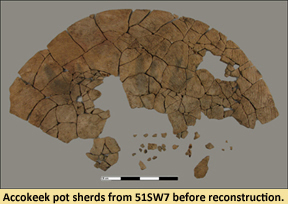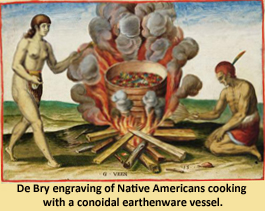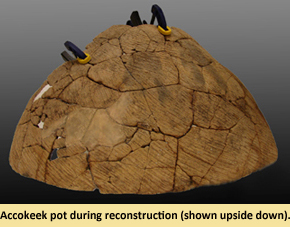An Accokeek Pot
July 2011
By Caitlin E. R. Shaffer, MAC Lab Conservator
 Pottery has been made for many thousands of years by cultures all over the world, each group developing their own styles, technologies, and traditions. In Maryland, the first ceramics were developed by Native Americans around 1000 B.C., and were unglazed, low-fired earthenware vessels used for storing and preparing food. The earliest pots had flat bottoms with short, hand-molded edges, which later developed into larger conoidal-shaped containers (Egloff and Woodward 1992:23). Ceramic pots proved to have great advantages over the previously used animal skin or stone vessels; the raw materials were readily available, and the pots kept food dry, were efficient for cooking, and were easily replaced when broken (Gardner 1986:66, Egloff and Woodward 1992:23).
Pottery has been made for many thousands of years by cultures all over the world, each group developing their own styles, technologies, and traditions. In Maryland, the first ceramics were developed by Native Americans around 1000 B.C., and were unglazed, low-fired earthenware vessels used for storing and preparing food. The earliest pots had flat bottoms with short, hand-molded edges, which later developed into larger conoidal-shaped containers (Egloff and Woodward 1992:23). Ceramic pots proved to have great advantages over the previously used animal skin or stone vessels; the raw materials were readily available, and the pots kept food dry, were efficient for cooking, and were easily replaced when broken (Gardner 1986:66, Egloff and Woodward 1992:23).
An excellent example of prehistoric Maryland pottery was discovered in 2009 during investigations of archaeological site 51SW7, which is situated near the confluence of the Anacostia and Potomac Rivers. This Early Woodland site is thought to have been a camp, possibly related to seasonal fishing, where cooking was a central activity (Katz 2011). Over 150 sherds of pottery from a single vessel were recovered and identified as Accokeek type pottery, dating from 1000-600 B.C.

 Accokeek pottery was made throughout Maryland and into Virginia. The iron-rich clay was mixed with sand or quartz temper to prevent shrinking and breaking during firing, and produced red, orange, tan or buff colored ware with black, brown or gray oxidized areas. Accokeek vessels were formed with hand-modeled bases and coil-constructed sides. The pots were shaped, smoothed and strengthened by striking the exterior walls with a paddle wrapped in cording made from plant fibers, which resulted in distinctive striated surface markings. It has been suggested that the cord was used during production to prevent the paddle from sticking to the wet clay, and that the rough texture of the finished pot was beneficial because it provided a good grip, and it increased the surface area of the pot’s exterior, resulting in quicker cooking times (Lynn 2003). The interiors were smoothed. Pots were made conoidal, semi-conoidal or globular because these shapes were strong, conducted heat well and could easily be propped up in a cooking fire (Egloff and Woodward 1992:23).
Accokeek pottery was made throughout Maryland and into Virginia. The iron-rich clay was mixed with sand or quartz temper to prevent shrinking and breaking during firing, and produced red, orange, tan or buff colored ware with black, brown or gray oxidized areas. Accokeek vessels were formed with hand-modeled bases and coil-constructed sides. The pots were shaped, smoothed and strengthened by striking the exterior walls with a paddle wrapped in cording made from plant fibers, which resulted in distinctive striated surface markings. It has been suggested that the cord was used during production to prevent the paddle from sticking to the wet clay, and that the rough texture of the finished pot was beneficial because it provided a good grip, and it increased the surface area of the pot’s exterior, resulting in quicker cooking times (Lynn 2003). The interiors were smoothed. Pots were made conoidal, semi-conoidal or globular because these shapes were strong, conducted heat well and could easily be propped up in a cooking fire (Egloff and Woodward 1992:23).
 The vessel excavated from 51SW7 is an exciting find. Although Accokeek sherds are often recovered at archaeological sites in the region, finding such a complete vessel is rare. It is typical of its type with buff, orange and gray coloring, and a cord-marked surface. It is semi-conoidal in shape, and it measures approximately sixteen inches in diameter by eight inches deep. Although the pot is missing its base and roughly 40% of one side, it was possible to reconstruct the sherds using an acrylic adhesive, support fills, clamps, and counterweights. The reconstruction has allowed for a better understanding of how the vessel would have originally looked, and gives us an appreciation for the craftsmanship of its maker. After nearly 3,000 years underground, this vessel has been reincarnated from everyday cooking vessel to show-stopping artifact!
The vessel excavated from 51SW7 is an exciting find. Although Accokeek sherds are often recovered at archaeological sites in the region, finding such a complete vessel is rare. It is typical of its type with buff, orange and gray coloring, and a cord-marked surface. It is semi-conoidal in shape, and it measures approximately sixteen inches in diameter by eight inches deep. Although the pot is missing its base and roughly 40% of one side, it was possible to reconstruct the sherds using an acrylic adhesive, support fills, clamps, and counterweights. The reconstruction has allowed for a better understanding of how the vessel would have originally looked, and gives us an appreciation for the craftsmanship of its maker. After nearly 3,000 years underground, this vessel has been reincarnated from everyday cooking vessel to show-stopping artifact!
Photographs courtesy of Joint Base-Anacostia Bolling (JBAB), Naval District Washington.
Illustration of cord-wrapped paddling courtesy of the Frank H. McClung Museum.
For more information on prehistoric pottery, please visit the Maryland Archaeological Conservation Laboratory’s Diagnostic Artifacts Website at http://www.jefpat.org/diagnostic/PrehistoricCeramics/index-prehistoric.html
| References |
|
| Egloff, Keith and Deborah Woodward |
| 1992 |
First People: The Early Indians of Virginia. University Press of Virginia, Charlottesville, VA. |
|
| Gardner, Wililam M. |
| 1986 |
Lost Arrowheads & Broken Pottery: Traces of Indians in the Shenandoah Valley. Thunderbird Publications, Manassas, VA. |
|
| Katz, Gregory |
| 2011 |
Bellevue's Telltale Heart (51SW7): Accokeek Under the Floorboards. Paper presented at Middle Atlantic Archaeological Conference, Ocean City, MD. |
|
| Lynn, Alvin |
| 2003 |
Making Cordmarked Pottery. Online document, http://www.texasbeyondhistory.net/theme/cordmarked/, accessed June 23, 2011. |
|